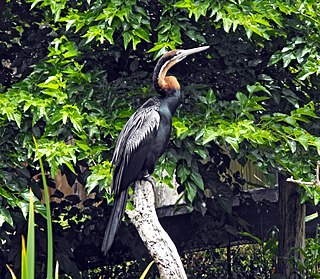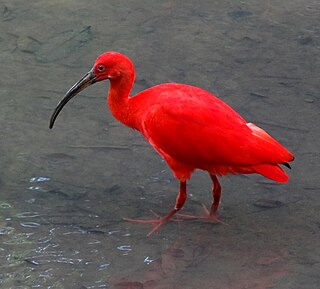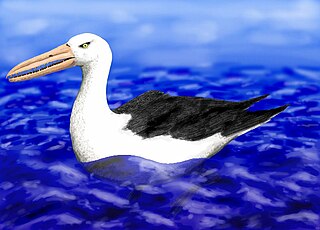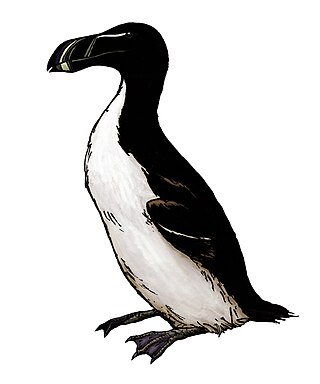
Loons or divers are a group of aquatic birds found in much of North America and northern Eurasia. All living species of loons are members of the genus Gavia, family Gaviidae and order Gaviiformes.

Pelicans are a genus of large water birds that make up the family Pelecanidae. They are characterized by a long beak and a large throat pouch used for catching prey and draining water from the scooped-up contents before swallowing. They have predominantly pale plumage, except for the brown and Peruvian pelicans. The bills, pouches, and bare facial skin of all pelicans become brightly coloured before the breeding season.

The darters, anhingas, or snakebirds are mainly tropical waterbirds in the family Anhingidae, which contains a single genus, Anhinga. There are four living species, three of which are very common and widespread while the fourth is rarer and classified as near-threatened by the IUCN. The term snakebird is usually used without any additions to signify whichever of the completely allopatric species occurs in any one region. It refers to their long thin neck, which has a snake-like appearance when they swim with their bodies submerged, or when mated pairs twist it during their bonding displays. "Darter" is used with a geographical term when referring to particular species. It alludes to their manner of procuring food, as they impale fishes with their thin, pointed beak. The American darter is more commonly known as the anhinga. It is sometimes called "water turkey" in the southern United States; though the anhinga is quite unrelated to the wild turkey, they are both large, blackish birds with long tails that are sometimes hunted for food.

Eudocimus is a genus of ibises, wading birds of the family Threskiornithidae. They occur in the warmer parts of the New World with representatives from the southern United States south through Central America, the West Indies, and South America.

Osteodontornis is an extinct seabird genus. It contains a single named species, Osteodontornis orri, which was described quite exactly one century after the first species of the Pelagornithidae was. O. orri was named after the naturalist Ellison Orr (1857-1951).

The Pelagornithidae, commonly called pelagornithids, pseudodontorns, bony-toothed birds, false-toothed birds or pseudotooth birds, are a prehistoric family of large seabirds. Their fossil remains have been found all over the world in rocks dating between the Early Paleocene and the Pliocene-Pleistocene boundary.

Copepteryx is an extinct genus of flightless bird of the family Plotopteridae, endemic to Japan during the Oligocene living from 28.4 to 23 mya, meaning it existed for approximately 5.4 million years.

Kyptoceras is a small extinct artiodactyl ungulate mammal of the family Protoceratidae, endemic to southeastern North America from the Miocene to Early Pliocene epoch 23.03—3.6 Ma, existing for approximately 19.43 million years. The species name, amatorum, comes in honor of all amateur fossil collectors, including Frank Garcia the amateur who found it and donated it to the Florida Museum of Natural History.
Palaeochenoides is a genus of the prehistoric pseudotooth birds of somewhat doubtful validity. These were probably rather close relatives of either pelicans and storks, or of waterfowl, and are here placed in the order Odontopterygiformes to account for this uncertainty.

Pelagornis is a widespread genus of prehistoric pseudotooth birds. These were probably rather close relatives of either pelicans and storks, or of waterfowl, and are here placed in the order Odontopterygiformes to account for this uncertainty.
Pseudodontornis is a rather disputed genus of the prehistoric pseudotooth birds. The pseudotooth birds or pelagornithids were probably rather close relatives of either pelicans and storks, or of waterfowl, and are here placed in the order Odontopterygiformes to account for this uncertainty. Up to five species are commonly recognized in this genus.

The Yorktown Formation is a mapped bedrock unit in the Coastal Plain of Maryland, Virginia, North Carolina and South Carolina. It is overconsolidated and highly fossiliferous.

Pinguinus alfrednewtoni is an extinct species of auk related to the great auk known from fossils that were discovered in the Pliocene Yorktown Formation of North Carolina. Like the great auk, it was a large flightless diving bird that used its wings to propel itself forward underwater. Only a limited amount of material is known, despite the rich diversity of fossil auks recovered from the Yorktown Formation. Due to this, it has been proposed that it was either a more coastal animal or simply not as common in more southern waters. This later suggestion could be supported by the discovery of relatively young P. alfrednewtoni remains, indicating that they may have overwintered in the region. One early hypothesis proposed that it was a direct ancestor to the great auk, but this idea is no longer supported. Instead, it is thought that it filled the same niche as its eastern relative, which eventually expanded into the western Atlantic after the extinction of P. alfrednewtoni.
Pelecanus odessanus is a large species of fossil pelican, described in 1886 from Late Miocene fossil material since lost, from Novaja Slobodka, near Odesa in the Ukraine. With a tarsometatarsus length of 150 mm (5.9 in), it was about the same size as Pelecanus schreiberi from the Early Pliocene of North America.

The jacanas are a group of tropical waders in the family Jacanidae. They are found in the tropical regions around the world. They are noted for their elongated toes and toenails that allow them to spread out their weight while foraging on floating or semi-emergent aquatic vegetation. They are also among the somewhat rare groups of birds in which females are larger, and several species maintain harems of males in the breeding season with males solely responsible for incubating eggs and taking care of the chicks.
Phoenicopterus floridanus is an extinct species of flamingo that lived during the Pliocene in what is now Florida and potentially North Carolina.
Gavia howardae is an extinct species of loon from the Piacenzian age from United States. Fossils of this bird were initially found in 1947 by Clifford Kennell in the San Diego Formation, California and were given a name in 1953 by Pierce Brodkorb. These first specimens consisted of humeri bones, which Brodkorb indicated based on the distal end of the humerus were a smaller species of the genus Gavia, with a possible relationship with the pacific loon. More specimens were collected from the same deposits covering the entirety of the wing, some more complete than others. Chandler (1990) described and published these new materials and found G. howardae to be related to the red-throated loon instead. Additional material has been recovered from the Yorktown Formation, North Carolina where in addition more wing bones, there were also remains of the leg and shoulder regions. Based on the overall size of the remains, G. howardae was on average smaller than the red-throated loon, and one of the smallest species of Neogene loons from North America.
Gavia fortis is an extinct species of loon from the Zanclean age from United States. Fossils of this bird have mostly been found in the Yorktown Formation from North Carolina and two specimens recovered from the Bone Valley Formation in Florida. Remains of this species is mostly the bones that make up the wing, the synsacrum, the legs and feet. Olson & Rasmussen who described the species in 2001 noted that the bones are markedly more robust, indicating this is the third largest species of loon to have existed, after the common loon and the yellow-billed loon. The authors believed G. fortis is indeed close to the ancestor of both of the aforementioned extant species.
Pliolymbus is a fossil genus of grebe known from the Late Pliocene to Early Pleistocene of United States and Mexico. It is known from a single species, P. baryosteus.
Podiceps howardae is a possible extinct species of grebe from the United States, possibly a larger and earlier form of the horned grebe.










